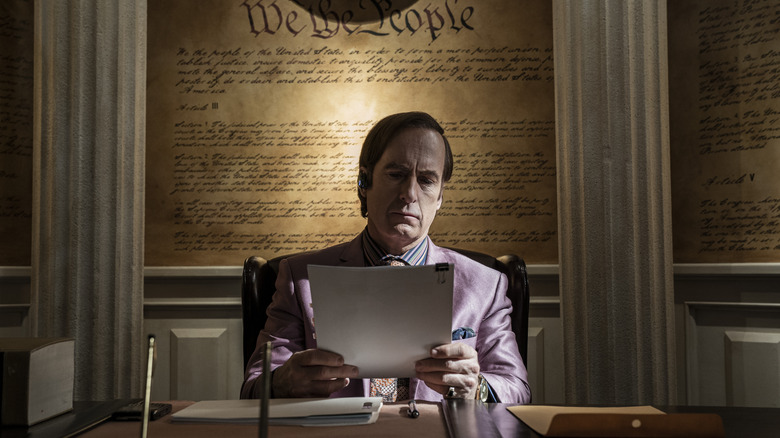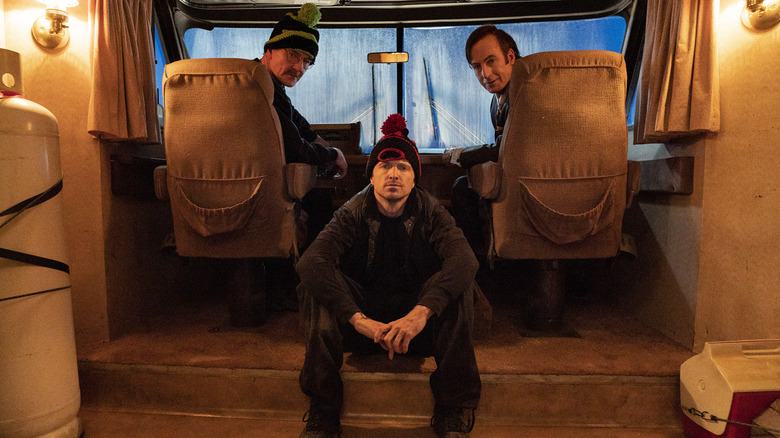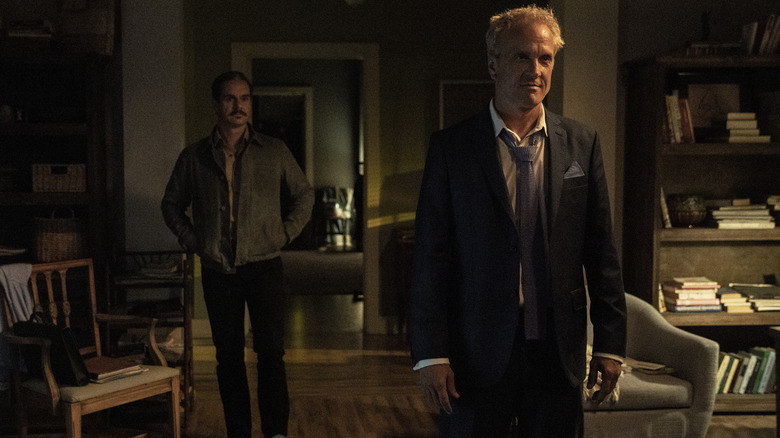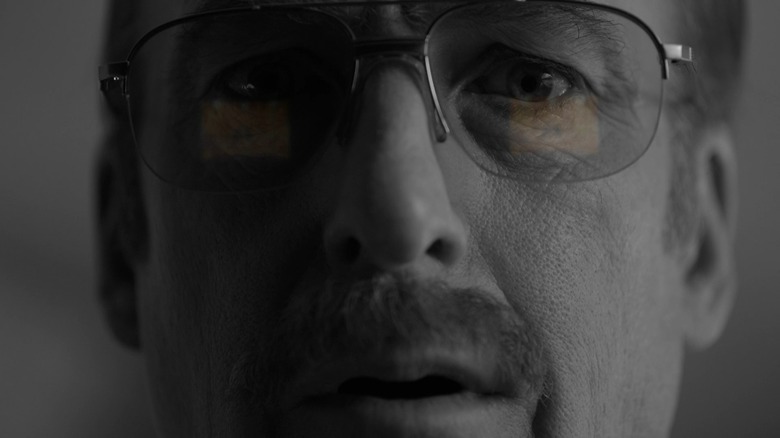Better Call Saul Finally Settled A Longstanding Breaking Bad Debate
As of this latest episode of "Better Call Saul," the show's penultimate hour, we're now right on the brink of witnessing how the stories of Jimmy McGill (Bob Odenkirk) and Kim Wexler (Rhea Seehorn) ultimately wrap up, for better or worse. Given some of those devastatingly sad moments and downright anxiety-inducing confrontations — as much interpersonal as they are an ongoing battle between the best and worst natures within our protagonists — all signs point towards a tragic (or at least deeply melancholic) conclusion. In other words, Gene Takovic's remark to the elderly Marion (Carol Burnett) a few episodes back about a "happy ending" now feels rather ominous.
Of course, this impending conclusion also marks the long-anticipated moment when this series finally loops around and connects with where Saul Goodman began as a supporting character in "Breaking Bad." Ever since "Better Call Saul" first aired in 2015, fans of the parent show were eager to compare how this upstart prequel measured up to the seemingly untouchable original. For the more casual viewers who came along for the ride, mostly lured in by Odenkirk's and Seehorn's impeccable performances and the promise of a very different series (both in terms of tone and structure) than "Breaking Bad," the early seasons proved surprisingly compelling for both subsets of fandom alike.
And yet, the nagging question of whether one was able to enjoy "Better Call Saul" to the fullest without having knowledge of the events of "Breaking Bad" remains ... or did, at least. The evidence pointing towards the need to know what fate awaits Jimmy in the future was there all along, but the last episode finally put a nail in that coffin and settled a longstanding debate.
Spoilers for "Better Call Saul" (and "Breaking Bad," as well!) follow.
It's about the journey, not the destination
On its surface, it probably feels obvious that, in order to fully enjoy "Better Call Saul," prior knowledge of the series it's spinning off from would be a requirement. And while that's undoubtedly true — the early reveal of Tuco Salamanca (Raymond Cruz) at the concluding moments of the very first episode of season 1, for example, wouldn't have the same impact on viewers who never witnessed his drug-fueled mania in "Breaking Bad" — the firsthand accounts of many fans nonetheless show how the experience could still be enriching in all the ways that actually matter.
Major characters like Jonathan Banks' Mike Ehrmantraut and Giancarlo Espositio's Gus Fring, both of whom originate from the original show, are still given proper introductions and serve crucial plot functions that are specific to "Better Call Saul" alone. Their respective journeys and motivations remain just as effective without thinking of their various run-ins in the future with Bryan Cranston's Walter White and Jesse Pinkman (Aaron Paul). While the black-and-white flash-forwards opening every season (until this last one, at least) might have thrown off the uninitiated, Jimmy and Kim's story still makes perfect sense as a standalone narrative of a flawed but well-intentioned man who struggles to overcome his basest instincts ... and who drags innocents down with him.
The drama, conflicts, and emotional punch are only ever enhanced by a complete, working knowledge of what happens down the line; it's never been dependent on it. But in perhaps the boldest creative choice in the entire series, that all began to change with every passing year until culminating in the sixth and final season.
A tale of two shows (in one)
The longer that "Better Call Saul" has gone on, the more that the boundary separating Jimmy McGill from Saul Goodman (from Gene Takovic) has started to crumble — by design, mind you.
With each passing season, the separation between Jimmy's legal profession and the criminal underworld that Saul will eventually become subsumed by have blended together more and more. Curiously (and frustratingly, to some viewers), the generally lighthearted shenanigans of Slippin' Jimmy and the cartel thriller plotline of Mike began to feel somewhat disconnected from one another. But as critic Alan Sepinwall astutely points out in his review of "Point and Shoot," the symbolism of rival attorney Howard Hamlin (Patrick Fabian) and cartel thug Lalo Salamanca (Tony Dalton) buried together in the same grave marks the beginning of the end of the two-shows-in-one structure of "Better Call Saul." As the transformation of Jimmy into Saul just about reaches its inevitable final stage (exacerbated, though not entirely caused, by Kim walking out of Jimmy's life), "Better Call Saul" itself no longer tried to keep the final destination of "Breaking Bad" at arm's length.
The effect on viewers, consequently, meant that only those fully aware of future events could enjoy (or, more accurately, dread) the dramatic irony and looming specter of Saul Goodman fully unleashed and Kim no longer around to keep his worst tendencies in check. In the last episode of "Better Call Saul," one specific scene finally established beyond a shadow of a doubt that viewers are expected to have seen "Breaking Bad" in all its tragedy.
A debate settled
In the penultimate episode of "Better Call Saul," the show's agonizingly deliberate pacing has since turned into a raging river, sweeping the con artist formerly known as Jimmy McGill away and leaving us with the hollowed-out pomp and circumstance of Saul Goodman and the timid (but no less damaged) shell of Gene Takovic. Amidst that flood, the show's priorities have changed markedly, resulting in nostalgic "Breaking Bad" reunions and various references to the parent series that have done the impossible: making both shows into richer and more meaningful experiences.
All this is made crystal clear (get it? Crystal?) during the course of Gene's harrowing phone call with Kim, only revealed in its entirety during the last episode. In between his unseemly ravings, he slips in the casual but fascinating detail that he knows that Mike, Gus, and Lalo are all dead and gone — the former two deaths having only occurred in "Breaking Bad." Those who only ever knew Mike and Gus from their appearances on the spin-off may have found this casual reveal either extremely anticlimactic or actually missed it altogether, but either way that one line makes the show's interconnectedness with "Breaking Bad" abundantly plain ... if it wasn't already.
The strength of "Better Call Saul" in its visual and subtextual storytelling means that, even without verbal acknowledgement, observant "Breaking Bad" fans have been rewarded with foreshadowing and recontextualizations that have taken full advantage of what we thought we knew about where things were headed. "Waterworks" underlines that point dramatically, confronting the washed-out world of Gene with the bombast and extravagance of "Breaking Bad"-era Saul.
Like a quintessential Jimmy courtroom argument, "Better Call Saul" hid this reveal in plain sight all along.
The "Better Call Saul" series finale airs on AMC Monday, August 15, 2022.



